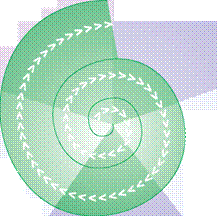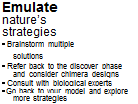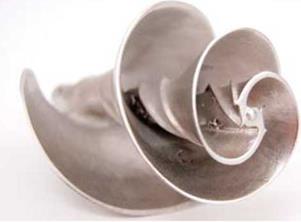In the words of the Biomimicry Guild, nature can be “model, measure, and mentor.”[14] This means that nature can be used as a guide to translate functions into biological terms. We can strive to discover and emulate nature’s processes and materials, evaluate solutions against nature’s own principles, and learn from nature as a source of information and strategies, not merely materials.
Because Biomimicry doesn’t suggest a tool set as much as it represents a way to think about and judge new solutions, developers might find it difficult to use Biomimicry as anything other than a source of inspiration for new solutions or new materials. Often, the framework is more helpful in formulating the processes of research
 |
|

 |
 |
and development of new materials and manufacturing processes rather than finding solutions to human needs. However, Biomimicry’s framework for the development process, the Design Spiral (see Figure 3.5), developed by Carl Hastrich in cooperation with the Biomimicry Guild, is a development process that maps roughly to contemporary design processes but from a biomimetic perspective.
Discover natural models
• Go outside
• Consider both literal and metaphorical models
• Comb the literature
• Brainstorm with biologists
• Create a taxonomy of life’s strategies
FIGURE 3.5. fWl http://www. flickr. com/photos/rosenfeldmedia/3258161413 The Design Spiral.
The Design Spiral from the Biomimicry Guild isn’t terribly different than the process many designers already enage in when designing new solutions. However, the order is somewhat different. Where contemporary design approaches suggest research, then prototyping, then evaluation, the Design Spiral expands the question of design brief through translation into similar biological processes (see Figure 3.6).
Biomimicry:
 (Repeat) (Repeat)
(Repeat) (Repeat)
Biomimicry teaches us to evaluate design solutions by comparing them with nature’s principles and processes. In this way, it’s an addition to the design process but not a replacement for it, since nature’s principles don’t reflect human requirements (either on an individual or societal level). So Biomimicry is a framework that should be used in combination with design processes, not instead of them. In fact, Biomimicry fits best into part of the design and
prototype phase since the objectives of design research and testing are focused more appropriately on evaluating human values and not natural values.
A more appropriate process that combines the two might be seen in Figure 3.7.
Biomimicry teaches us to evaluate design solutions by comparing them with nature’s principles and processes.
Design Process:
(Repeat)
Blomlmlcry: (Repeat)
FIGURE 3.7. http://www. flickr. com/photos/rosenfeldmedia/3258185739 Combining the two processes into one.
Developers using any contemporary development process should find it comforting to know that their current processes—especially other spiral-based processes such as Extreme Programming—can work within the Biomimicry framework with little modification. Instead, a shift in perspective and priorities is most important. Throughout any process, questions of the environment and nature’s solutions can help focus developers on critical issues, inspirations, and possible solutions already existing in nature. For example, it’s already common that designers carefully cast new product specifications in terms of human needs and outcomes. However, the Design Spiral also asks us to question the brief from nature’s perspective: “How does nature accomplish this?” and “What are nature’s needs?” The Design Spiral asks us to recast the location of solutions in nature’s terms as well—habitat, climate, nutrients, and so on.
Biomimicry doesn’t offer much guidance in terms of social or financial sustainability. It is primarily focused on environmental impacts. Indeed, nature isn’t a system that reflects human values so it can’t be used to guide decisions made about them. However, even in nature, there may be answers to social and financial models of sustainability. In fact, throughout the entire development process, biomimicry reminds us to “look for answers already resolved in nature.”
…throughout the entire development process, biomimicry reminds us to “look for answers already resolved in nature.”
PAX Scientific
An impressive example of Biomimicry resulting in superior solutions involves the products from PAX Scientific and its subsidiaries. These seemingly simple impellers take their form from carefully observing vortexes in nature (see Figure 3.8). PAX’s founder, Jay Harmon, and his scientists designed the complex, multiple-axis
|
FIGURE 3.8. http://www. flickr. com/photos/rosenfeldmedia/3258976826 The hyper-efficient design of this impeller was inspired by nature. |
PAX Scientific
shape of their impellers around the most efficient geometries they found in biological systems (including plants and animals). As a result, their pumps dramatically increase the amount of water or air they move or mix (depending on the application), increasing efficiency and reducing power consumption, noise, drag, and costs. In addition, the designs are carefully optimized for manufacturing to reduce material use and waste. Their products have been so efficient and successful, that PAX is applying these designs to every imaginable use of moving fluids, from automobiles to laptop computers to wastewater management. www. paxscientific. com




